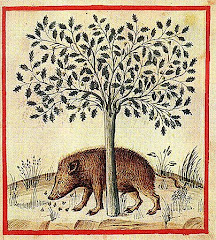 And just as well I didn't burden myself with the SLR since, having walked a distance along a route we thought we'd memorised so well that we didn't bother to bring the map, we found ourselves lost as substantially as we did on our first attempt last year.Even, dare I say it, worse.
And just as well I didn't burden myself with the SLR since, having walked a distance along a route we thought we'd memorised so well that we didn't bother to bring the map, we found ourselves lost as substantially as we did on our first attempt last year.Even, dare I say it, worse.
 We spent a good deal of time traversing high flung branches and performing balancing acts along logs before, dragging our way through endless marsh and bramble, we finally saw daylight on the other side and found ourselves in the Physician's Meadow once again - a bleak landscape of tufted grass littered with small streams and the sound of water trickling, unseen, through the tall sedges.
We spent a good deal of time traversing high flung branches and performing balancing acts along logs before, dragging our way through endless marsh and bramble, we finally saw daylight on the other side and found ourselves in the Physician's Meadow once again - a bleak landscape of tufted grass littered with small streams and the sound of water trickling, unseen, through the tall sedges. After another short walk, and a sit down to savour the sun and quiet for a bit longer, we re-entered the forest in the right place and headed to the well.
After another short walk, and a sit down to savour the sun and quiet for a bit longer, we re-entered the forest in the right place and headed to the well. ...along with the little cup left there for visitors by the Potters of Myddfai who live in a farm on the far side of the heath...
...along with the little cup left there for visitors by the Potters of Myddfai who live in a farm on the far side of the heath... ...and several common medicinal plants are also beginning to make their presence known in the surrounding area. Lots of Foxglove (Digitalis purpurea) is coming up, a plant the Physicians of Myddfai are said to have used for stomach tumours rather than as a powerful (and dangerous) drug for the heart as is the modern use.
...and several common medicinal plants are also beginning to make their presence known in the surrounding area. Lots of Foxglove (Digitalis purpurea) is coming up, a plant the Physicians of Myddfai are said to have used for stomach tumours rather than as a powerful (and dangerous) drug for the heart as is the modern use.  I also saw several patches of little violets (Viola riviniana) around - another plant used by the physicians though I don't remember what for - and a species of lady's mantle (Alchemilla mollis possibly?) which I don't remember seeing on the Myddfai list but which had a famous reputation for saving the lives of many women during childbirth as a result of its ability to stop haemorrhage.
I also saw several patches of little violets (Viola riviniana) around - another plant used by the physicians though I don't remember what for - and a species of lady's mantle (Alchemilla mollis possibly?) which I don't remember seeing on the Myddfai list but which had a famous reputation for saving the lives of many women during childbirth as a result of its ability to stop haemorrhage.  As well as these, there were several more tasty plants in evidence, of which my favourite has to be bramble (Rubus fruticosus). The young shoots of this plant can be eaten raw, a revelation made to me only last year.
As well as these, there were several more tasty plants in evidence, of which my favourite has to be bramble (Rubus fruticosus). The young shoots of this plant can be eaten raw, a revelation made to me only last year. Although so many turn their nose up at them (my entire family included), I find them unbelievably moreish. If soft and young enough, the tannin content is minimal, but still apparent, causing a slight puckering in the mouth. This is followed by a pleasant blackcurrant/blackberry type aftertaste along with another very full flavour I simply can't describe.
Although so many turn their nose up at them (my entire family included), I find them unbelievably moreish. If soft and young enough, the tannin content is minimal, but still apparent, causing a slight puckering in the mouth. This is followed by a pleasant blackcurrant/blackberry type aftertaste along with another very full flavour I simply can't describe.It has to be tried for the flavour to be understood and I really recommend persevering a few times to develop a proper appreciation. Once I've started eating these I find it very difficult to stop although they can get a bit much after a while. I had debated trying something like bramble shoot crumble, but I fear I would be isolated in my enthusiasm for it so I never have. If anyone else has ever appreciated this gourmet wild food I'd love to hear your thoughts!
Another edible worthy of mention is the lanceleaf plantain (Plantago lanceolata) which is beginning to make an appearance. They must be caught young since they turn bitter fast, but if the very young leaves in the centre of the rosette are eaten raw or thrown sparingly into a salad they can add a delicious flavour remarkably like mushroom.
 Finally, I must comment on the wood sorrel (Oxalis acetosella) and the common little daisy (Bellis perennis) which also make such tasty snacks. The former with a sharp rhubarb-like flavour from the oxalic acid which makes it very refreshing though unsuitable for anyone with kidney problems and the latter with a warm fragrant flavour to the early flowers whilst the edible leaves are almost flavourless, but are at least available almost all year round.
Finally, I must comment on the wood sorrel (Oxalis acetosella) and the common little daisy (Bellis perennis) which also make such tasty snacks. The former with a sharp rhubarb-like flavour from the oxalic acid which makes it very refreshing though unsuitable for anyone with kidney problems and the latter with a warm fragrant flavour to the early flowers whilst the edible leaves are almost flavourless, but are at least available almost all year round. Of course, with all of these I've found it best to enjoy them early in the season. Not only can they turn a little bitter later on, but it may also be deemed unpleasant to have to compete with so many aphids for the tenderest shoots.
 Finally, I saw this fascinating growth (above) occasionally on the main paths. If anyone could enlighten me as to what it is I would be very interested - sorry the photo's not very good. I wouldn't be surprised if it wasn't cropping up in places previously fertilised by the friendly wild horses who we had the pleasure of meeting again on this occasion. This time they came within yards of us and contemplated us for quite a while before concluding that they would rather not go past and decided to amble back the way they had come.
Finally, I saw this fascinating growth (above) occasionally on the main paths. If anyone could enlighten me as to what it is I would be very interested - sorry the photo's not very good. I wouldn't be surprised if it wasn't cropping up in places previously fertilised by the friendly wild horses who we had the pleasure of meeting again on this occasion. This time they came within yards of us and contemplated us for quite a while before concluding that they would rather not go past and decided to amble back the way they had come. And of course, I should mention that the photo at the top of this post is the view of the Black Mountains including the hills around Llyn-y-Fan-Fach as seen from the Usk Reservoir where we started our walk.
And of course, I should mention that the photo at the top of this post is the view of the Black Mountains including the hills around Llyn-y-Fan-Fach as seen from the Usk Reservoir where we started our walk.











4 comments:
Lovely articles, Kristina! Sacred wells are another of my hobbies. I've only visited about 5/6 in Wales but have chalked up around 47 of the 131 in Cornwall! Do you belong to the wells and spas email list?
Wells and Spas e-mail list? Do tell!
I had no idea such a thing could exist.
It's called Water Talk and you can join at the website https://www.jiscmail.ac.uk/cgi-bin/webadmin?A0=WELLS-AND-SPAS
The list is only sporadically active, but everybody who is anybody on the "Wells scene" either belongs to the list or knows how to contact them. They're a nice bunch and come up with some really interesting stuff from time to time including special offers on new books on wells.
Thanks for that Sarah, I'm on to it already.
Post a Comment